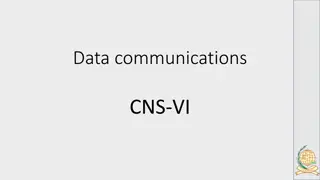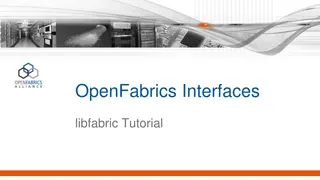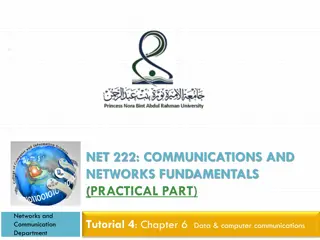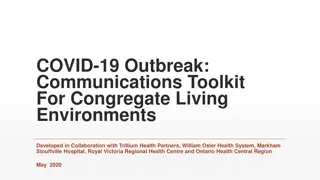Fundamentals of Communications and Networks in the Networks and Communication Department Tutorial
Exploring various encoding schemes and signal codes, such as Unipolar, NRZ-L, NRZ-I, Manchester, and Differential Manchester, along with practical exercises like extracting clock information and data sequences from Manchester-encoded streams. The tutorial covers topics like delta modulation, encoding data using MFSK, and more in the field of networks and communication.
Download Presentation

Please find below an Image/Link to download the presentation.
The content on the website is provided AS IS for your information and personal use only. It may not be sold, licensed, or shared on other websites without obtaining consent from the author.If you encounter any issues during the download, it is possible that the publisher has removed the file from their server.
You are allowed to download the files provided on this website for personal or commercial use, subject to the condition that they are used lawfully. All files are the property of their respective owners.
The content on the website is provided AS IS for your information and personal use only. It may not be sold, licensed, or shared on other websites without obtaining consent from the author.
E N D
Presentation Transcript
1 NET 222: COMMUNICATIONS AND NETWORKS FUNDAMENTALS (PRACTICAL PART) Networks and Communication Department Tutorial 3
Plan 2 This Week 8 Week 9 Week 10 Week 11 Week 12 tutorial 2 tutorial 3 lab 4,5 + revision Evaluation 2 on lab 4,5 Quiz tutorial 1 , 2 , 3 Networks and Communication Department
Q 1 3 Assume a data stream is made of ten alternate 0 s & 1 s. Encode this stream, using the following encoding schemes. Unipolar, NRZ-L, NRZ-I, Manchester, Differential Manchester Networks and Communication Department
Rules 4 Networks and Communication Department
S 1 5 Networks and Communication Department
Q 2 6 Sketch the signal waveforms when 00110101 is transmitted in the following signal codes. i) NRZ L ii) Manchester Code Networks and Communication Department
S 2 7 Networks and Communication Department
Q3 8 For the Manchester encoded binary stream of the following, extract the clock information and the data sequence. Networks and Communication Department
S3 9 1 0 1 0 0 1 1 1 0 0 1 Networks and Communication Department
Q4 10 The analog waveform shown in the following figure is to be delta modulated. The sampling period and the step size are indicated by the grid. The first DM output is also shown. Give the DM output for the complete signal. Networks and Communication Department
S4 11 Networks and Communication Department
Q5 12 Given the bit pattern 101001000011, encode this data using MFSK assume each signalling element represents with 3-bits. ? Networks and Communication Department
S5 13 Answer : 2^3 , M= 8 Networks and Communication Department
Q 5.1 14 Which of the signals of Table 5.2 use differential encoding Networks and Communication Department
S6 15 Answer: NRZI, Differential Manchester. Networks and Communication Department
Q 5.11 16 Given the bit pattern 01100, encode this data using ASK, BFSK, and BPSK. Networks and Communication Department
S 5.11 17 Networks and Communication Department
The End 18 Any Questions ? Networks and Communication Department























